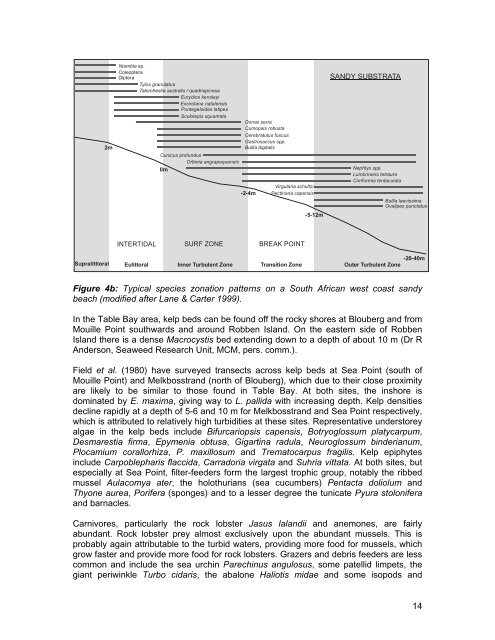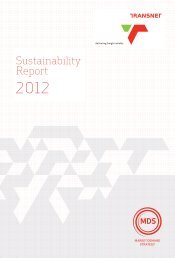BEN SCHOEMAN DOCK BERTH DEEPENING Specialist ... - Transnet
BEN SCHOEMAN DOCK BERTH DEEPENING Specialist ... - Transnet
BEN SCHOEMAN DOCK BERTH DEEPENING Specialist ... - Transnet
You also want an ePaper? Increase the reach of your titles
YUMPU automatically turns print PDFs into web optimized ePapers that Google loves.
Niambia sp.<br />
Coleoptera<br />
Diptera<br />
Tylos granulatus<br />
SANDY SUBSTRATA<br />
2m<br />
Eurydice kensleyi<br />
Excirolana natalensis<br />
Pontegeloides latipes<br />
Scololepis squamata<br />
Donax serra<br />
Cumopsis robusta<br />
Cerebratulus fuscus<br />
Gastrosaccus spp.<br />
Bullia digitalis<br />
Cunicus profundus<br />
Orbinia angrapequensis<br />
0m<br />
Virgularia schultzi<br />
-2-4m Pectinaria capensis<br />
-5-12m<br />
Nephtys spp.<br />
Lumbrineris tetraura<br />
Cirriformia tentaculata<br />
Bullia laevissima<br />
Ovalipes punctatus<br />
INTERTIDAL SURF ZONE BREAK POINT<br />
-20-40m<br />
Eulittoral Inner Turbulent Zone Transition Zone Outer Turbulent Zone<br />
Figure 4b: Typical species zonation patterns on a South African west coast sandy<br />
beach (modified after Lane & Carter 1999).<br />
In the Table Bay area, kelp beds can be found off the rocky shores at Blouberg and from<br />
Mouille Point southwards and around Robben Island. On the eastern side of Robben<br />
Island there is a dense Macrocystis bed extending down to a depth of about 10 m (Dr R<br />
Anderson, Seaweed Research Unit, MCM, pers. comm.).<br />
Field et al. (1980) have surveyed transects across kelp beds at Sea Point (south of<br />
Mouille Point) and Melkbosstrand (north of Blouberg), which due to their close proximity<br />
are likely to be similar to those found in Table Bay. At both sites, the inshore is<br />
dominated by E. maxima, giving way to L. pallida with increasing depth. Kelp densities<br />
decline rapidly at a depth of 5-6 and 10 m for Melkbosstrand and Sea Point respectively,<br />
which is attributed to relatively high turbidities at these sites. Representative understorey<br />
algae in the kelp beds include Bifurcariopsis capensis, Botryoglossum platycarpum,<br />
Desmarestia firma, Epymenia obtusa, Gigartina radula, Neuroglossum binderianum,<br />
Plocamium corallorhiza, P. maxillosum and Trematocarpus fragilis. Kelp epiphytes<br />
include Carpoblepharis flaccida, Carradoria virgata and Suhria vittata. At both sites, but<br />
especially at Sea Point, filter-feeders form the largest trophic group, notably the ribbed<br />
mussel Aulacomya ater, the holothurians (sea cucumbers) Pentacta doliolum and<br />
Thyone aurea, Porifera (sponges) and to a lesser degree the tunicate Pyura stolonifera<br />
and barnacles.<br />
Carnivores, particularly the rock lobster Jasus lalandii and anemones, are fairly<br />
abundant. Rock lobster prey almost exclusively upon the abundant mussels. This is<br />
probably again attributable to the turbid waters, providing more food for mussels, which<br />
grow faster and provide more food for rock lobsters. Grazers and debris feeders are less<br />
common and include the sea urchin Parechinus angulosus, some patellid limpets, the<br />
giant periwinkle Turbo cidaris, the abalone Haliotis midae and some isopods and<br />
14

















